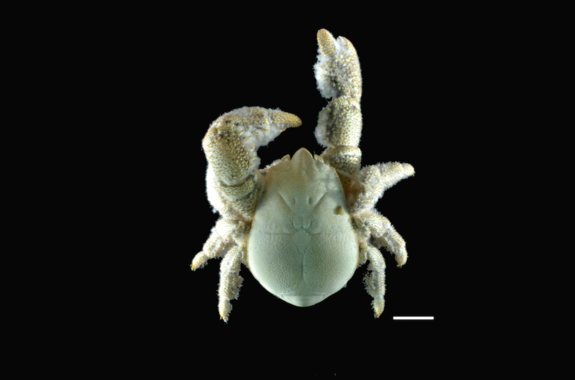New Wildlife Species Announced: Antarctic Hairy Chested Yeti Crab — It Even Grows Its Own Food!

(EnviroNews World News) — Even as wildlife species are disappearing off the face of the planet forever at an absolutely horrifying rate, scientists are still discovering new ones more often than you might think. One of the most recent additions to the list of new species is Kiwa tyleri, a.k.a., Hairy Chested Yeti Crab, or the “Hoff Crab” (after David Hasselhoff’s hairy bod on Baywatch).
The species was actually first discovered back in 2010 off the coast of Antarctica, and although there are two other recently discovered types of yeti crabs, the Hoff is the only one known to have full-body hair — a place where it amazingly cultivates its own bacterial food source.
There are only three types of yeti crabs known to science, and besides their whiteness, blindness and hairiness (all characteristics of the abominable snowman), what distinguishes them from other crustaceans is they all live near, or directly on hydrothermal vents on the deep ocean floor. The Hoff crab lives basically on top of highly sulfuric, 720 degree Fahrenheit, dark, sooty, gushers — down about 8,500 feet under the surface of the ocean where temperatures average around 30 degrees.

The crab is reliant upon, and has evolved as a result of this highly unique environment — a tiny underwater strip located in the East Scotia Ridge — an area of the Southern Atlantic Ocean in between Antarctica and South America. Photographs were taken of the hairy critter by team expedition leader Alex Rogers — a zoology professor at Oxford University, and those pictures reveal areas where the animals are “heaped up upon each other” at an amazingly thick 600 crabs per square meter.

Reportedly though, not all crabs get to remain and enjoy the heat from both the other crabs and the vents, as the poor females have to wander away into the icy deep to lay their eggs — whereat directly after, they die. It is thought they are too depleted and weak to return to the comfortable warmth of the “thermal envelope” whence they came. It is not known to EnviroNews at this time how long the males, who apparently do not leave the comfort of the pocket, are able to live.
On June 24, 2015, researchers, for the first time in an in-depth morphological paper published in PLOS One Journal, described the distinct characteristics of the newly-known species.
LiveScience reported on the research paper thusly in its article:
Many of the yeti crab’s distinctive features — like its stark white coloring and its “hairy” body — are the creature’s adaptations to its habitat, the researchers said. K. tyleri dwells in a “thermal envelope” of just a few square meters, where the water is just the right temperature, said Sven Thatje, lead author of the report and associate professor of marine evolutionary ecology at the University of Southampton in England.

Of the three Kiwa species of blind crab, only K. tyleri has the hairy Hasselhoff chest — a place where it literally tends to its own food. Amazingly, a type of bacteria known as “symbiotic proteobacteria” which metabolize methane and hydrogen sulfide gas (H2S) put off by the vents, grow throughout the hair-like substrate known as “setae.”
The other two Kiwa species also have hair, albeit not full body hair like K. tyleri. Kiwa hirsuta, discovered less than a decade ago itself in 2005, also has the special bacteria-harboring setae growing on its arms. It was found in cold waters 1,500 miles south of Easter Island at a depth of 7,200 feet.

Shortly thereafter in 2006 it was announced that Kiwa puravida, a second species had been discovered at about 3,300 feet in Costa Rican waters. It is said that this species actively waves its appendages over the seeping vents in order to get more oxygen and nutrients to the bacteria it meticulously cultivates.

All three yeti crabs compose an entirely new family of decapods know as Kiwaidae — an awesome group of “abominable crabs” that inhabit the boiling, seeping, chimney-like hydrothermal vents of the planet’s icy deep oceans.
Another cool thing about Kiwa tyleri is that it has, once again, put David Hasselhoff in the spotlight. Hey who knows? — Excluding Knight Rider (because what could be cooler than Knight Rider?), having an entirely new species of crab named after him may be one of the neatest things David Hasselhoff has done in his illustrious career in a good while. We, at EnviroNews, would like to interview him on that very topic soon.
FILM AND ARTICLE CREDITS
- Emerson Urry - Journalist, Author



